The Places of Worship (Special Provisions) Act, 1991
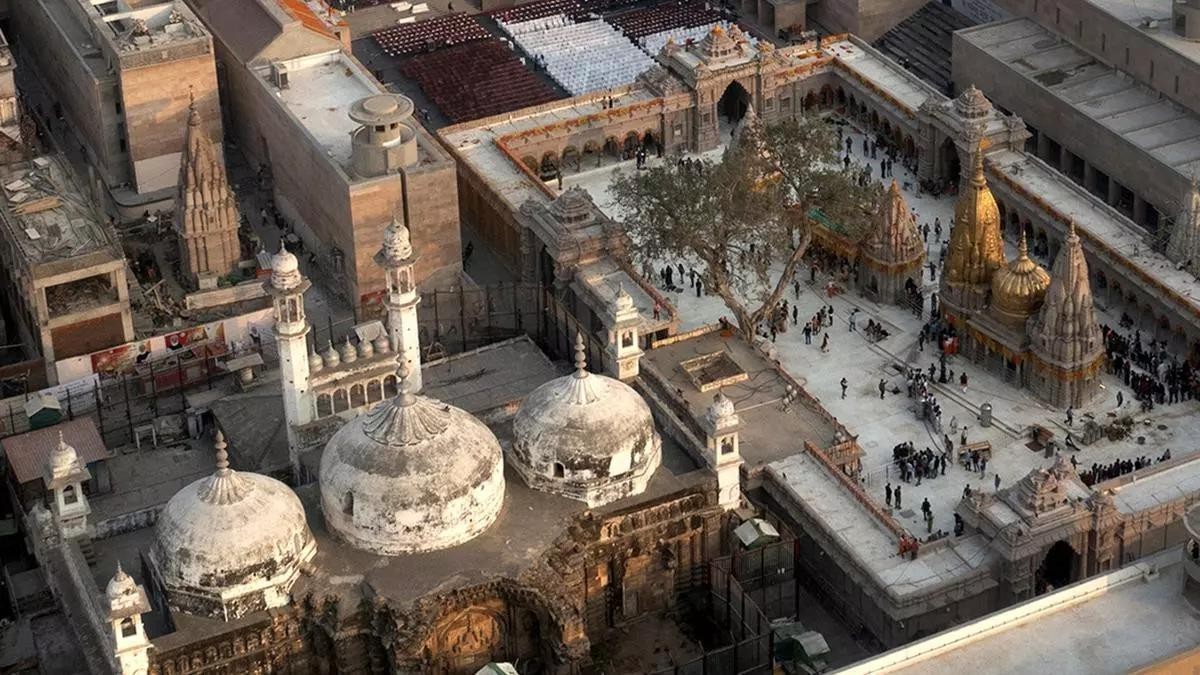
"Law and justice are not always the same. When they aren’t, destroying the law may be the first step toward changing it."
Context:
- The Supreme Court of India on December 12, 2024 barred civil courts across the country from registering fresh suits challenging the ownership and title of any place of worship, and from ordering surveys of disputed religious places until further orders.
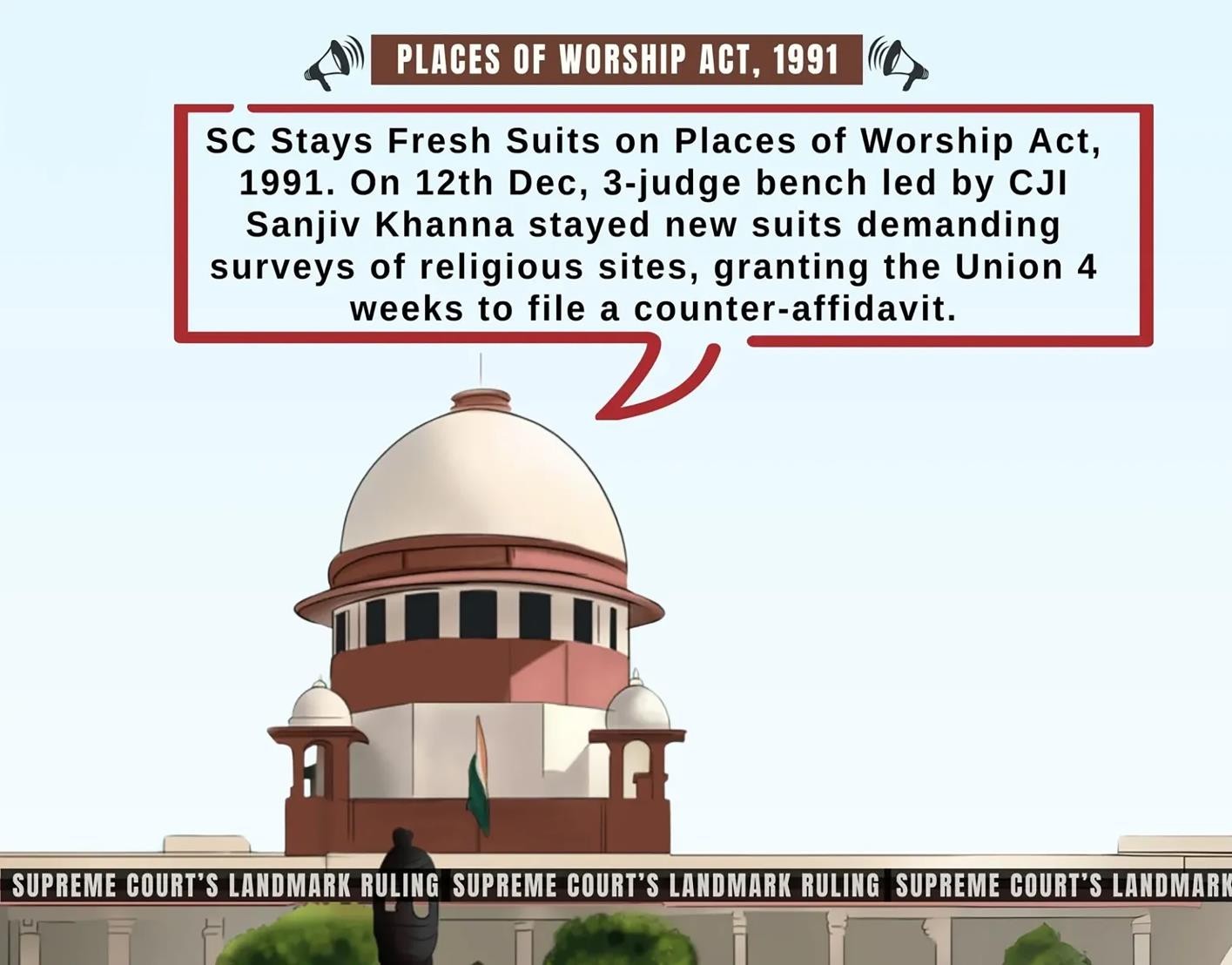
1.
What is the Places of Worship Act, 1991?
- On 18 September 1991, Parliament passed the Places of Worship Act, 1991.
- The law was passed with the object of prohibiting conversion of any place of worship and to provide for the maintenance of the “religious character” of any place of worship as it existed on the 15th day of August, 1947.
- The Act does not apply to the Ram Janmabhoomi-Babri Masjid.
- The Act had come into being at a time when the communal tension, more specifically regarding the Ram Janmabhoomi movement and the dispute regarding Babri Masjid, had escalated.
- It was brought in by the Congress government headed by Prime Minister P.V. Narasimha Rao to avoid further religious conflicts and maintain communal harmony.
2.
What prompted the introduction of the Places of Worship Act of 1991?
- When the Babri Masjid-Ram Janmabhoomi dispute was at its height, in the early 1990s, the Vishwa Hindu Parishad (VHP) and other Hindu organisations also laid claim to two other mosques the Gyanvapi mosque in Varanasi and the Shahi Idgah in Mathura.
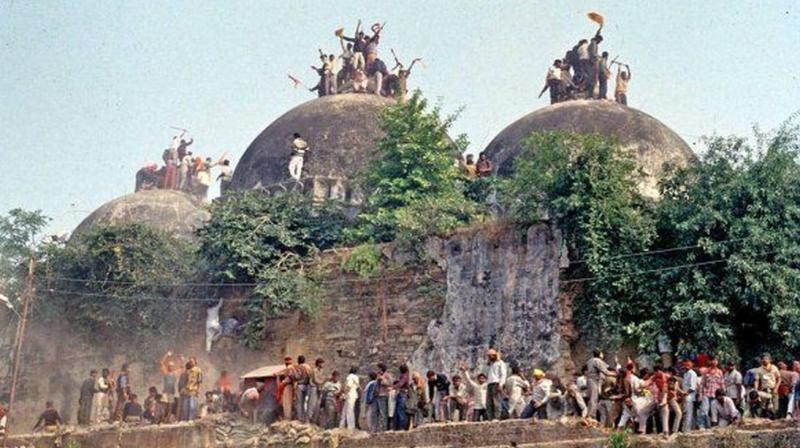
- Although the radicals in the Hindu camp often spoke of reclaiming 3,000 mosques across the country, they threatened to start agitations only in respect to these two places of worship.
- The demolition resulted in several months of intercommunal rioting between India's Hindu and Muslim communities, causing the death of at least 2,000 people.
- In this backdrop, the P.V. Narasimha Rao government enacted, in September 1991, a special law to freeze the status of places of worship as they were on August 15, 1947.
- It was hoped that the legislation would help the preservation of communal harmony in the long run.
- The law kept the disputed structure at Ayodhya out of its purview, mainly because it was the subject of prolonged litigation.
- It was also aimed at providing scope for a possible negotiated settlement.
3.
Enlist key provisions of the Places of Worship Act, 1991?
- The key provisions of Places of Worship Act,1991 are as follows:
| Provisions | Analysis |
|---|---|
| Section 3- Prohibition of Conversion |
|
| Section 4(1)- Maintenance of Religious Character |
|
| Section 4(2)- Abatement of Pending Cases |
|
| Section 6 - Punishment for Contravention |
|
4.
What are the exceptions to the Places of Worship Act, 1991?
- Section 5 of the Places of Worship Act, 1991 provides for the certain exceptions to the Act which are as follows:
| Provision | Analysis |
|---|---|
| Ancient and historical monuments |
|
| Settled cases |
|
| Conversions before the Act |
|
| Ram JanmabhoomiBabri Masjid |
|
5.
Enlist a recent series of events?
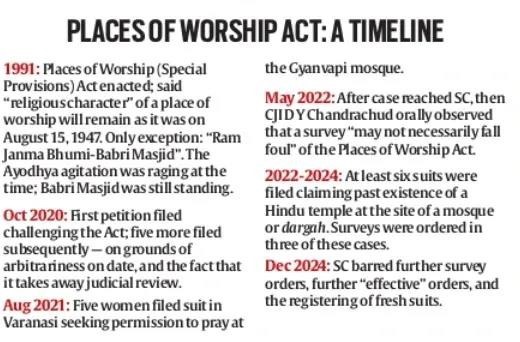
| Date | Event |
|---|---|
| 28th October 2020 |
|
| 12th March 2021 |
|
| May 2022 |
|
| 14th November 2022 |
|
| November 2024 |
|
| 6th December 2024 |
|
| 7th December 2024 |
|
| 12th December, 2024 |
|
6.
What was the stance of various political parties over the Places of Worship Act, 1991, when the bill was introduced?
- The 1991 Act had been brought in by the then Congress government of Prime Minister P V Narasimha Rao at a time when the Ram temple movement was at its peak.
- The Bill was introduced in the Lok Sabha by then Home Minister S B Chavan with the objective of “prohibiting conversion of places of worship and to provide for the maintenance of their religious character as it existed on August 15, 1947”.
- The Bill was introduced in the 1991 Monsoon Session, and saw at least eight hours of debate, marred by frequent interruptions and expunged remarks, with intense opposition from the BJP‟s side.
| Political party | Stand |
|---|---|
| Indian National Congress |
|
| BJP stand |
|
| Communist Party of India (Marxist) |
|
| All India Majlis-eIttehadul Muslimeen (AIMIM) |
|
| Janta Dal |
|
7.
Enlist various religious disputed sites where suits were filed?
| Sites | News |
|---|---|
| Shahi Jama Masjid, Sambhal |
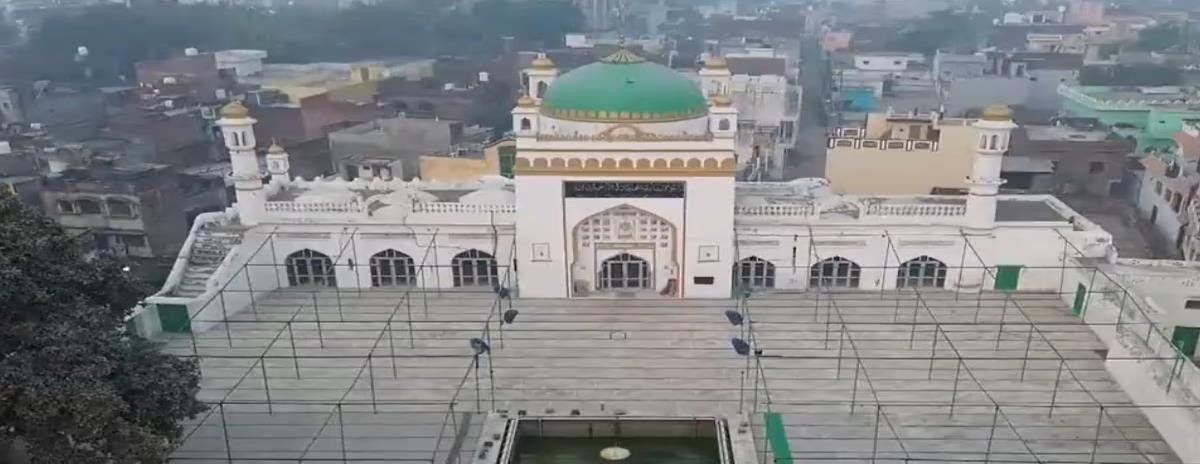 |
| Gyanvapi Mosque in Varanasi |
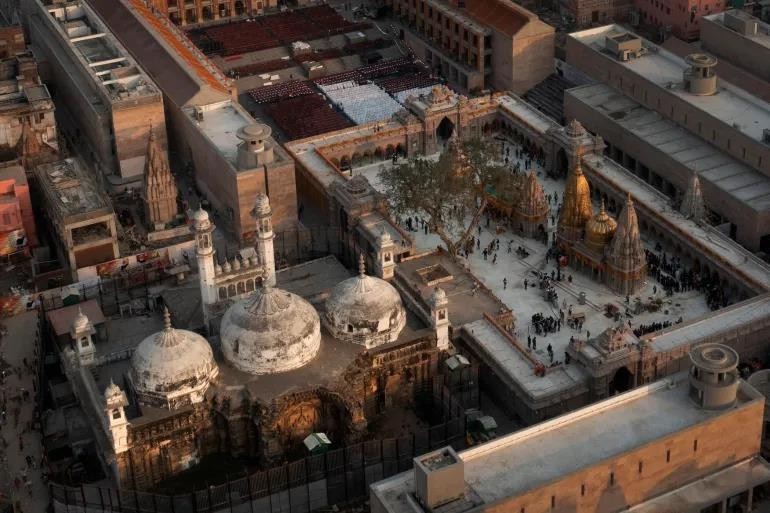 |
| Shahi Eidgah Masjid in Mathura |
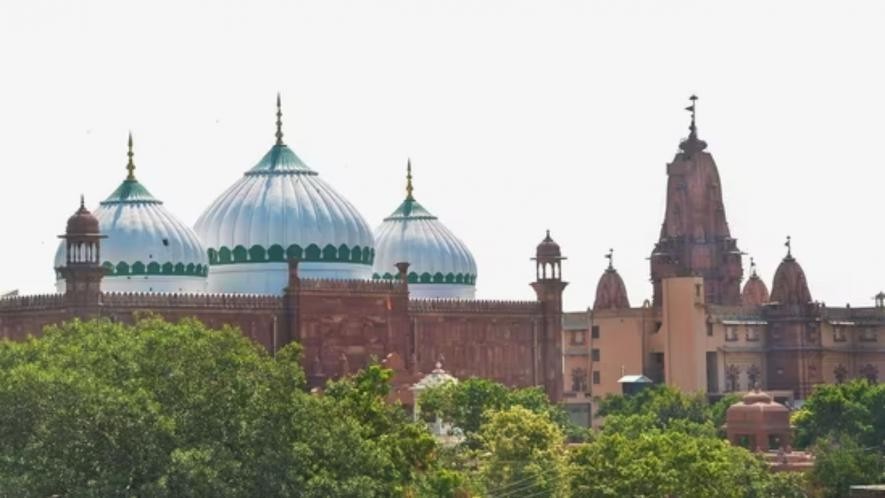 |
| Ajmer Dargah in Rajasthan |
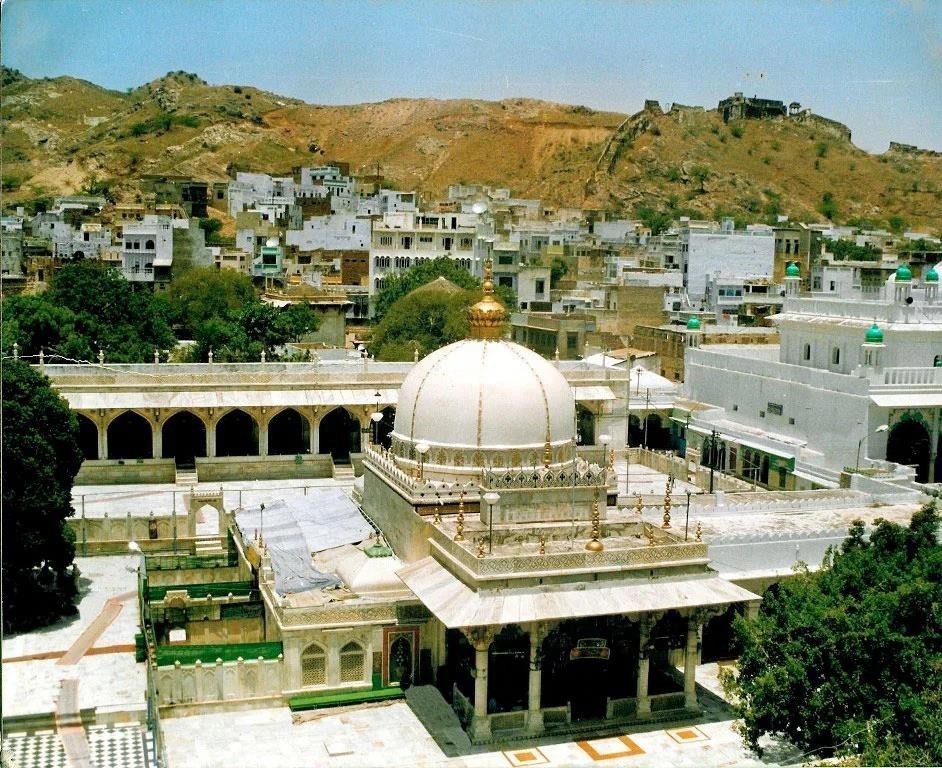 |
8.
What are the key issues with the Places of Worship Act, 1991?
| Issues | Analysis |
|---|---|
| Violation of Article 14 |
|
| Violation of Articles 25 and 26 |
|
| Contradiction with the Basic Structure Doctrine |
|
| Bar on Judicial Review |
|
9.
What is the Ayodhya case, and what was its verdict?
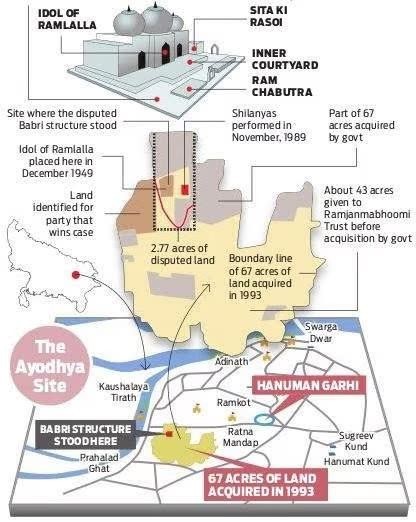


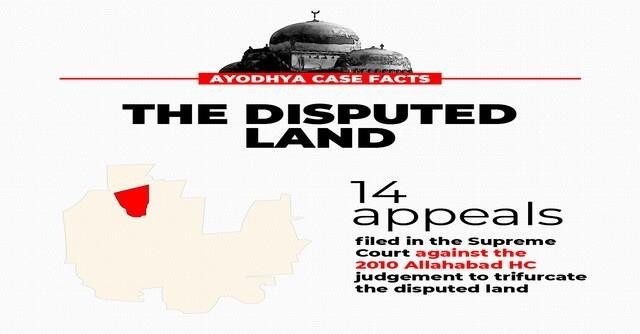
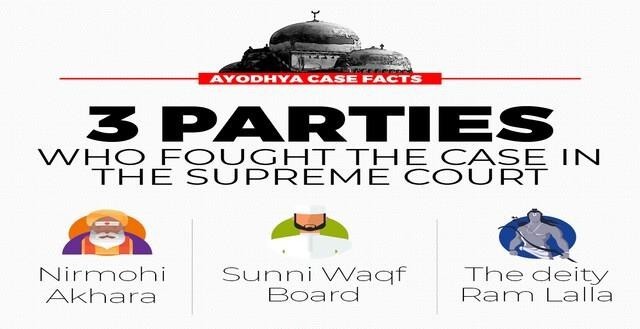
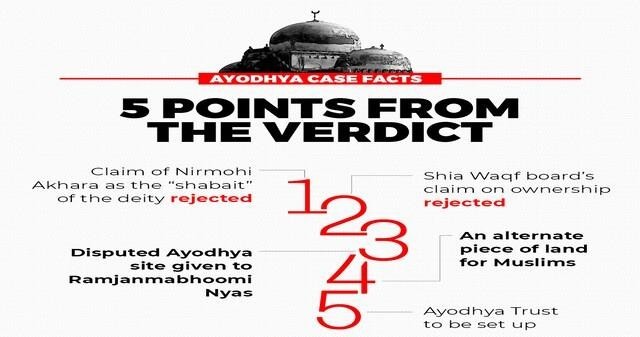
- The Supreme Court of India's verdict on the Ayodhya title dispute was delivered on November 9, 2019:
| Beneficiary | Description |
|---|---|
| Land for the temple |
|
| Land for the mosque |
|
10.
What is the present status of Gyanvapi and Shahi Idgah mosque?
| Places of Worship | Present status |
|---|---|
| Gyanvapi Mosque, Varanasi |
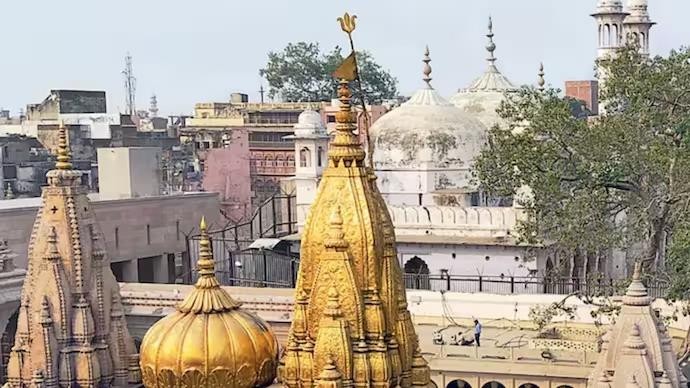 |
| Shahi Idgah, Mathura |
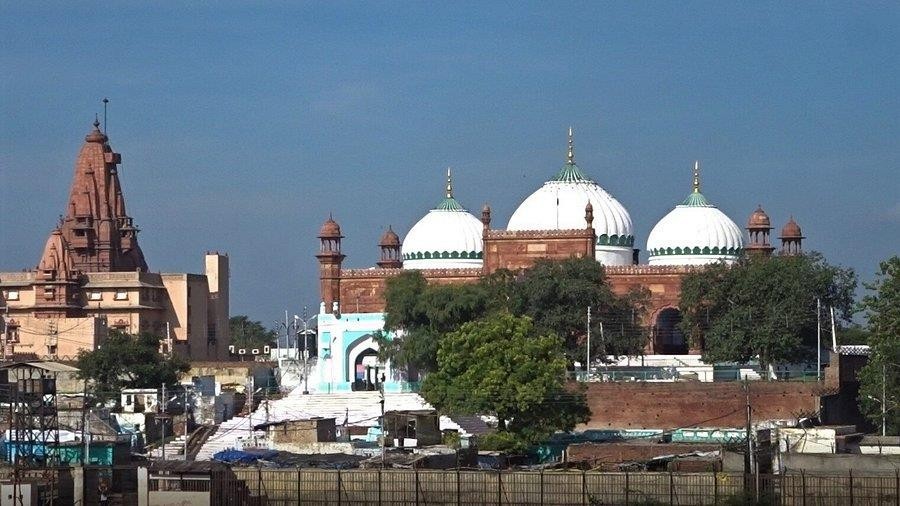 |
11.
Did the Supreme Court refer to The Places of Worship (Special Provisions) Act, 1991 in its Ayodhya judgment?
- In the landmark 2019 Ayodhya verdict, a five-judge Constitution Bench of the Hon‟ble Supreme Court described the Act as integral to the “basic structure of the Constitution.”
- In its verdict, the Supreme Court commended the enactment as one that preserved the constitutional value of secularism by not permitting the status of a place of worship to be changed.
- The state has, by enacting the law, enforced a constitutional commitment and operationalised its constitutional obligations to uphold the equality of all religions and secularism, which is a part of the basic features of the Constitution.
- According to the Supreme Court Places of Worship Act “imposes a non-derogable obligation towards enforcing our commitment to secularism.”
- The court observed that “non-retrogression is a foundational feature of the fundamental constitutional principles, of which secularism is a core component.”
- Although the Act was not directly challenged in that particular case, the Court‟s recognition of its importance in upholding constitutional values could play a significant role in shaping its scrutiny in the ongoing legal proceedings.
12.
On what grounds is The Places of Worship Act, 1991 challenged in the Supreme Court?
- The lead Petition challenging the Act was filed by BJP leader and lawyer Ashwini Kumar Upadhyay in 2020, who alleged that the Act violates Articles 25 and 26 of the Constitution by restricting the right to practice and manage religious affairs.
- He argues that the Act is discriminatory, barring religious communities from approaching courts to reclaim places of worship and questioning the then Centre’s authority to enact such legislation.
- Other Petitioners include the Vishwa Bhadra Pujari Purohit Mahasangh, represented by Advocate Vishnu Shankar Jain, and BJP leader Subramanian Swamy.
- Subramanian Swamy calls the Act “void ab initio,” claiming it infringes on Article 25 by barring Hindus from praying at temples converted during foreign invasions and seeks the same exemption granted to the Ram Janmabhoomi-Babri Masjid site for the Kashi Vishwanath and Krishna Janmabhoomi Mathura temples.
- The petitioners have challenged the Act on two key grounds:
| Ground | Provision |
|---|---|
| Violation of judicial review |
|
| Arbitrary nature of Act |
|
13.
What will be the impact of the recent Supreme Court ruling?
- The Supreme Court of India on December 12, 2024 barred civil courts across the country from registering fresh suits challenging the ownership and title of any place of worship, and from ordering surveys of disputed religious places until further orders.
- The order applies to both civil suits that are already pending (there are several) and to those that may be filed in the future.
- The order bars the “registration” of cases by civil courts.
- Consequently, civil courts also cannot order a survey, or seek a report from the Archeological Survey of India (ASI), as they have done in several recent instances.
- All these civil cases have raised questions on the title of mosques, arguing that they were built on Hindu religious structures that were razed by medieval rulers.
- The Supreme Court also observed that court orders in these civil suits could be challenged on the grounds that they violate larger constitutional principles of secularism and the rule of law, irrespective of the Places of Worship Act.
- Meanwhile, the SC will have to hear the constitutional challenge to the 1991 Act.
14.
Enlist core issues that are to be resolved by the Supreme Court of India?
- The Supreme Court has identified several critical issues that require deliberation:
| Sections 3 and 4 of the Places of Worship Act, 1991 |
|
|---|---|
| Judicial remedies |
|
| Historical injustices |
|
| Conflicts with the secular fabric of the Constitution |
|
| Role of District Courts |
|
| Other clarifications |
|
15.
What are Hydra Heads?
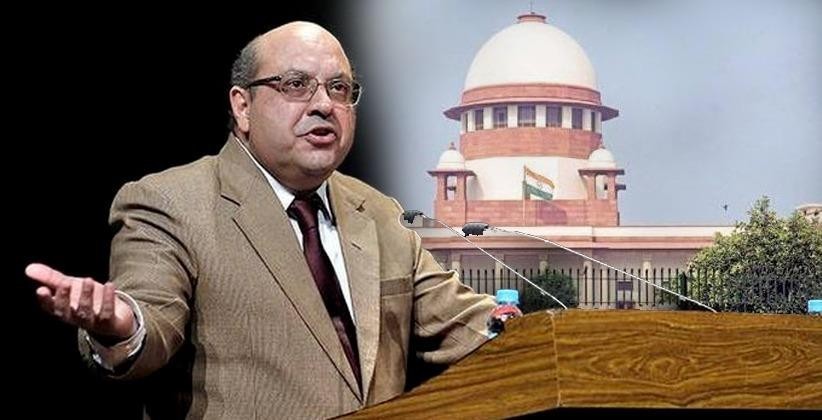
- In his recent speech at the First Justice A.M. Ahmadi Memorial Lecture on „Secularism and the Indian Constitution‟, former Supreme Court judge Rohinton Nariman compared the recent suits disputing the origin and existence of not only mosques, but also dargahs, as “hydra heads” which need to be cauterised.
- The former judge termed the per curiam (anonymous) Ram Janmabhoomi judgment which gave the site of the demolished Babri Masjid to the Hindu claimants — as a travesty of justice against secularism, but noted that the verdict‟s only silver lining was that it too had upheld the Places of Worship Act.
16.
What is the view of different sections of society on The Places of Worship Act, 1991?
- The Places of Worship (Special Provisions) Act 1991, has been a subject of enduring controversy since its enactment.
- Fundamentally, the Act invites critical examination of whether it represents a moral framework or a contentious settlement disguised in the language of secularism.
| Sections of society | View |
|---|---|
| Majoritarian view |
|
| Minority view |
|
17.
What are the views of Historians?
| HIstorian | View |
|---|---|
Syed Ali Nadeem Rezavi, a history professor at Aligarh Muslim University
 |
|
| Ram Puniyani |
|
What is the relevance of the topic for UPSC CSE?
For Prelims: The Places of Worship (Special Provisions) Act, 1991.
For Mains: Indian Constitution, The Places of Worship (Special Provisions) Act, 1991, Related Provisions
Some Previous Years Prelims Questions
Q1. Consider the following statements: (2020)
1. The Constitution of India defines its ‘Basic Structure’ in terms of federalism, secularism, fundamental rights and democracy.
2. The Constitution of India provides for ‘judicial review’ to safeguard the citizens’ liberties and to preserve the ideals on which the Constitution is based.
Which of the statements given above is/are correct?
(a) 1 only
(b) 2 only
(c) Both 1 and 2 only
(d) Neither 1 nor 2
Some Previous Years Mains Questions
Q1. Are tolerance, assimilation and pluralism the key elements in the making of an Indian form of secularism? Justify your answer [2022]
Q2. What are the challenges to our cultural practices in the name of secularism? [2019]
Q3. What can France learn from the Indian Constitution’s approach to secularism? [2019]
Q4. How is the Indian concept of secularism different from the western model of secularism? Discuss. [2018]
Some Questions from This Year and Previous Years Interview Transcripts
Board Lt Gen Raj Shukla sir:
- Do you know the Places of Worship Act?
- What is its crux?
- Why is there an issue in Gyanvapi etc?
Board B B Swain sir:
- Tell me something about Places of worship act 1991?
Some Questions for QUIZ
Q1. Consider the following statements with respect to the Places of Worship Act, 1991.
1. It recognises only temples and mosques as a place of worship.
2. Selling or purchasing of places of worship is not prohibited under the Act.
3. The act aims to maintain the religious character of any place of worship as it existed on August 15, 1947.
How many of the statements given above are correct?
(a) Only one
(b) Only two
(c) All three
(d) None
Q2. Which of the following rulers have constructed the Gyanvapi mosque in Varanasi?
(a) Babur
(b) Jahangir
(c) Aurangzeb
(d) Balban
Q3. Which of the following rulers have constructed the Babri mosque in Ayodhya?
(a) Babur
(b) Jahangir
(c) Balban
(d) Mir Baqi
Some Questions for POLL
Q1. Should exceptions be granted to Gyanvapi and Shahi Eidgah under Places of Worship Act, 1991?
(a) YES
(b) NO
(c) Can’t say
Q2. Is Places of Worship Act, 1991 violative of Basic Structure of constitution?
(a) YES
(b) NO
(c) Can’t say
QUICK LINKS